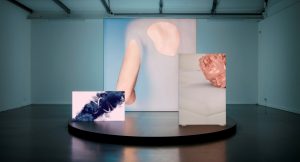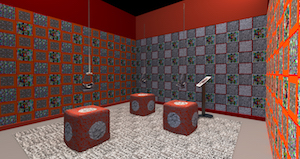Claudia Hart
October 3, 2018 5:00 PM–6:00 PM
Frank-Ratchye STUDIO for Creative Inquiry
CMU College of Fine Arts, Room CFA-111
Steiner Lecture in Creative Inquiry
Co-presented with the Miller Institute for Contemporary Art
Claudia Hart // Steiner Lecture in Creative Inquiry, 10/03/2018 from STUDIO for Creative Inquiry on Vimeo.
Claudia Hart emerged as part of a generation of 90s intermedia artists in the “identity art” niche. She still examines identity, but updated through the scrim of technology. Her art is about issues of the body, perception, and nature collapsing into technology and then back again. Hart was an early adopter of virtual imaging, using 3D animation to make media installations and projections, then later as they were invented, other forms of VR, AR, and objects using computer-driven production machines, all based on the same computer models. At the School of the Art Institute of Chicago, she developed a pedagogic program based on this concept – Experimental 3D – the first art-school curriculum dedicated solely to teaching simulations technologies in an art-world context. She lives between New York and Chicago, works with Transfer gallery and bitforms galleries, and is married to the Austrian media artist Kurt Hentschlager.
This lecture is made possible by the Sylvia and David Steiner Speaker Series and the Frank-Ratchye STUDIO for Creative Inquiry at Carnegie Mellon University.
Refreshments will be served. Open to the public.

Curated by Elizabeth Chodos
Oct. 5, 2018 – Feb. 3, 2019
Thurs. Oct. 4, 6-8pm: Reception
Thurs, Nov 8, 6–8pm: Salon Discussion lead by Dana Bishop-Root
Artists: Zach Blas, Brian Bress, Nick Cave, Kate Cooper, Stephanie Dinkins, Jes Fan, Claudia Hart, Eunsu Kang, Jillian Mayer, Sarah Oppenheimer, Siebren Versteeg
Additional events + public programming to be announced soon!
This exhibition explores the primacy of the human body as it’s poised on the precipice of a potential fusion with artificial intelligence. Inspired by the Moravec Paradox, the show looks deeper into the unconscious role the body’s sensorimotor habitat has in shaping our awareness, imagination, and socio-political structures. Society tends to privilege reason and logic because it is conscious and quantifiable. But beneath this thin “veneer of human thought” is a deeper, more complex knowledge system within the body. As technologists imagine the potentials of merging humans with AI, these artists consider the body’s elusive and underestimated power. Their various investigations across multiple media offer room to speculate about the exchange between the unconscious and conscious, and ask questions about what the body knows. Before we enter a generation where cyborgs are as ubiquitous as the internet, in a time when we still inhabit human bodies, the urgent questions to ask are what lessons can our mortal vessels teach us and what unknown paradox might we contain?
For more information on this and other Miller ICA exhibitions and events, visit http://millergallery.cfa.cmu.edu/
